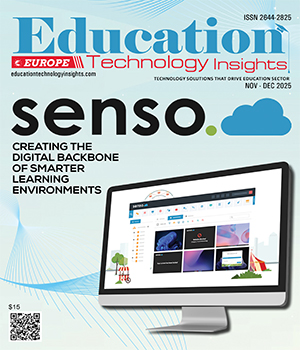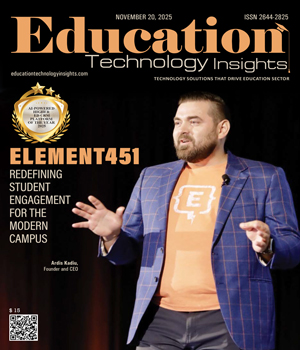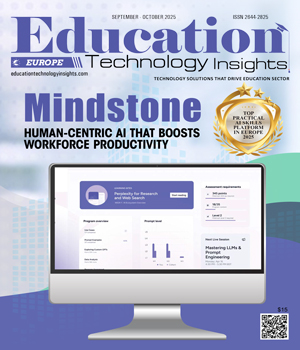THANK YOU FOR SUBSCRIBING
Be first to read the latest tech news, Industry Leader's Insights, and CIO interviews of medium and large enterprises exclusively from Education Technology Insights
Digital Transformation with User-Centric Solutions and Collaborative Leadership
Harald Rotter, CIO and CDO, University of St.Gallen (HSG)
 Harald Rotter, CIO and CDO, University of St.Gallen (HSG)
Harald Rotter, CIO and CDO, University of St.Gallen (HSG)Harald is an IT leader focused on modernizing digital ecosystems through practical, user-centered solutions, organizational thinking and cross-sector innovation. With experience in IT operations, consulting and changed projects, he combines technical expertise, agile practices and collaborative leadership to drive sustainable digital transformation, learning and value creation.
Three experiences in particular characterize my approach to modernizing the digital ecosystem. Firstly, practical relevance—my previous professional background and years of operating IT services have shown me that digital solutions only create real value if they are reliable, easy to use and closely aligned with the real needs of users. Secondly, the perspective from consulting and change projects—technical solutions must be embedded in processes, governance and business logic; otherwise, their benefits quickly fizzle out. Thirdly, there must be willingness to adapt concepts from other sectors. Outside the higher education sector, there are often pragmatic patterns that can be transferred, provided that their transferability is examined carefully and with the will to try something new. In my opinion, technical competence plus organizational thinking and an inquisitive but testing attitude are the basis for sustainable modernization.
Pragmatic Agility and Technology-Driven Innovation
For us, agile frameworks such as SAFe and Scrum are tools, not dogmas. The guiding principles behind them are decisive. We work in a value stream-oriented manner instead of in silos, divide large transformation projects into iterative, risk-minimized increments and operate platforms as products with defined service levels, APIs and user orientation. Technically, we rely on modern infrastructure and automated tests, with clear SLA definitions supplemented by lean but binding governance for security, data protection and compliance. People issues are at least as necessary: empowered teams, clearly defined product owner responsibilities and continuous coaching make agility effective in the long term. Our assessment on innovation is based on pragmatic criteria: educational and operational added value, legal and data protection fit, integration effort into the existing platform landscape, as well as the maturity and scalability of the ecosystem. I see GenAI as very relevant for teaching, research and administration—from personalized learning paths to assistance functions for routine processes—but only under strict data governance, bias checks and transparency. Blockchain is helpful for specific use cases such as verifiable certificates, but it is not a panacea; decentralization must deliver real added value. Digital workplace solutions are immediately transformative: modern collaboration, identity and communication platforms bring tangible productivity and communication gains in the short term. Quantum remains on the watch list: relevant for research, but not yet widely applicable operationally
Organizational Change Through Collaboration and Learning
The biggest hurdles caused by cultural and technical shifts are silo thinking, diverging stakeholder priorities, regulatory risk aversion and the gap between existing capabilities and the requirements of new technologies. Our approach is multi-level: early, transparent communication and informal dialogs create trust; co-design formats involve stakeholders in requirements and tests and increase ownership; small, measurable pilot projects deliver visible success and momentum. At the same time, we systematically build skills through upskilling programs and communities of practice. We design governance as a lean framework—binding, but not blocking. Leadership must be a role model: enable participation, delegate responsibility and define failure as a learning opportunity
One thing I would like to advice to young IT leaders is to think in terms of ecosystems, not individual solutions; test new things quickly and in a controlled manner, but only scale in a disciplined manner when there is demonstrable added value. Invest consistently in platforms, but also in people, training and leadership—this is the only way to achieve economies of scale and reusable and stable services. Establish simple, binding guardrails for security, data protection and compliance; they are the basis for trustworthy innovation. Maintain stakeholder management as an ongoing task: presence in committees, regular informal exchanges and transparent decision-making processes create the trust that large-scale transformations require. And remain curious, self-critical and modest about your impact— successful transformation is a continuous process of courage, pragmatism and willingness to learn.
Read Also
Designing Engagement That Lasts
Digital Creativity as a Catalyst for Deeper Learning
Protecting Precious Cargo: A Comprehensive Look at School Bus Safety
Student Employees: Your Next IT Investment
How Simmons University Is Reinventing itself and Making History With a Concentration In Women's Sports Management & Leadership
From Access to Belonging: Building a New Blueprint for Engagement and Equity

I agree We use cookies on this website to enhance your user experience. By clicking any link on this page you are giving your consent for us to set cookies. More info

However, if you would like to share the information in this article, you may use the link below:
www.educationtechnologyinsightseurope.com/cxoinsights/harald-rotter-nid-3459.html






















